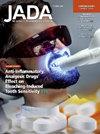家庭或办公室牙齿漂白对树脂浸润后白斑病变颜色稳定性的影响
IF 3.5
2区 医学
Q1 DENTISTRY, ORAL SURGERY & MEDICINE
引用次数: 0
摘要
作者研究了办公室牙齿漂白(IB)和家庭牙齿漂白(HB)后树脂浸润性白斑病变(WSL)的颜色稳定性,并评估了染色和再漂白的可能性。方法对60颗无龋第三磨牙进行脱矿处理,并将其分为4组:(1)不处理组(对照组);(2)脱矿+树脂浸润组;(3)脱矿+树脂浸润+ IB组;(4)脱矿+树脂浸润+ HB组。暴露于咖啡溶液中模拟12个月的染色电位后,进行第二次漂白程序。使用标准化数字成像在10个确定的时间点获得颜色测量值,并在国际eclairage - l∗a∗b∗(亮度,红绿轴,黄蓝轴)颜色空间中进行分析。为了精确地记录颜色变化,时间点包括基线、WSL创建后、树脂浸润后、漂白程序后、热循环(老化)后、咖啡暴露后和再漂白后。结果IB和HB在初始漂白(P = 0.127)和后续漂白(P = 0.111)后的漂白效果无显著差异。同样,12天后IB组和HB组之间的染色电位无显著差异(P = .867)。两种漂白方法都能使WSL染色后的颜色恢复到接近基线的水平。结论IB和HB在体外染色后均能使树脂浸润的wsl的颜色恢复到接近基线水平,两种方法之间无显著差异。尽管治疗结果显示对美白方案有反应,但染色条件下的颜色稳定性仍然有限,强调需要进一步研究长期维护策略。实际意义:一旦有足够的临床研究证据,IB和HB入路在临床上对于维持治疗后WSLs的美学稳定性都是可行的。本文章由计算机程序翻译,如有差异,请以英文原文为准。
Influence of home or in-office tooth bleaching on the color stability of white-spot lesions after resin infiltration
Background
The authors investigated the color stability of resin-infiltrated white-spot lesions (WSL) after in-office tooth bleaching (IB) or home tooth bleaching (HB) and assessed the potential for staining and rebleaching.
Methods
Sixty caries-free third molars were demineralized to create WSLs and then divided into 4 groups: (1) no treatment (control) group; (2) demineralization plus resin infiltration group; (3) demineralization plus resin infiltration plus IB group; (4) and demineralization plus resin infiltration plus HB group. After exposure to coffee solution to simulate 12-month staining potential, a second bleaching procedure was performed. Color measurements were obtained at 10 defined time points using standardized digital imaging and analyzed in the Commission Internationale de l’Eclairage-L∗a∗b∗ (lightness, red-green axis, yellow-blue axis) color space. To precisely document color changes, time points included baseline, after WSL creation, after resin infiltration, after bleaching procedures, after thermocycling (aging), after coffee exposure, and after rebleaching.
Results
No significant differences in bleaching effectiveness were observed between IB and HB after initial (P = .127) or subsequent (P = .111) bleaching. Similarly, there were no significant differences (P = .867) in staining potential between the IB and HB groups after 12 days. Both bleaching methods restored the WSL color close to the baseline after staining.
Conclusions
Both IB and HB restored the color of resin-infiltrated WSLs to near-baseline levels after staining in vitro, with no significant differences between the 2 methods. Although results of the treatments showed responsiveness to whitening protocols, color stability under staining conditions remained limited, highlighting the need for further investigation into long-term maintenance strategies.
Practical implications
Both IB and HB approaches may be clinically viable for maintaining the esthetic stability of treated WSLs over time once sufficient evidence from clinical studies becomes available.
求助全文
通过发布文献求助,成功后即可免费获取论文全文。
去求助
来源期刊

Journal of the American Dental Association
医学-牙科与口腔外科
CiteScore
5.30
自引率
10.30%
发文量
221
审稿时长
34 days
期刊介绍:
There is not a single source or solution to help dentists in their quest for lifelong learning, improving dental practice, and dental well-being. JADA+, along with The Journal of the American Dental Association, is striving to do just that, bringing together practical content covering dentistry topics and procedures to help dentists—both general dentists and specialists—provide better patient care and improve oral health and well-being. This is a work in progress; as we add more content, covering more topics of interest, it will continue to expand, becoming an ever-more essential source of oral health knowledge.
 求助内容:
求助内容: 应助结果提醒方式:
应助结果提醒方式:


